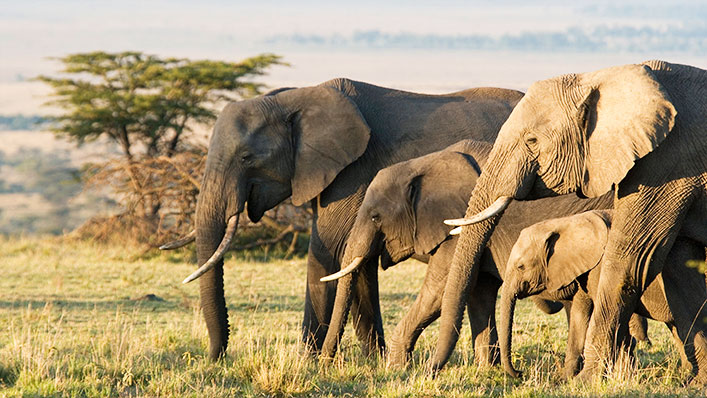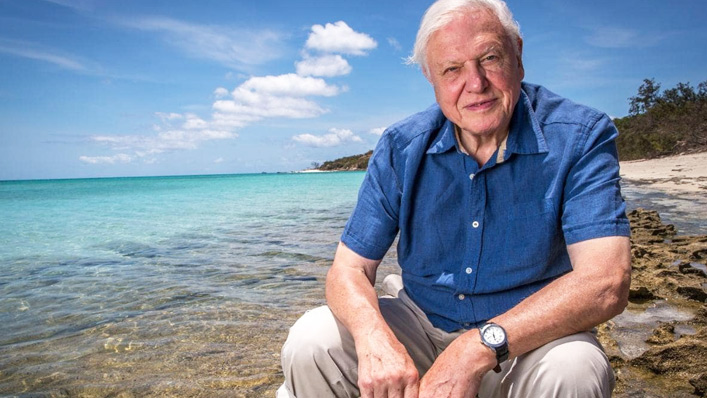Elephant and the soul-replenishing allure of nature documentaries

Stuck inside and getting cabin fever? Now’s a good time to feast your eyes on nature documentaries, writes critic Sarah Ward, including the Meghan Markle-narrated Disney+ film Elephant.
When Disney dallies with nature documentaries via the Disneynature label, it typically delivers exactly what everyone expects. As seen in films such as African Cats, Bears, Penguins and Dolphin Reef, the entertainment behemoth takes a happy, schmaltzy, crowd-pleasing look at animal life—making feel-good movies filled with stunning footage that peers intimately at various critters, while also spinning dramatic stories relayed via cutesy celebrity-voiced narration.
See also
* All new movies & series on Disney+
* All new streaming movies & series
Arriving with much fanfare due to its famous narrator—Meghan Markle, the Duchess of Sussex—Elephant fits the mould perfectly. Co-helmed by experienced Disneynature director Mark Linfield and producer-turned-filmmaker Vanessa Berlowitz (a veteran of the David Attenborough school of nature docos) this “awwwww, look at that”-style documentary aims to warm hearts by soliciting two key responses from viewers: “Aren’t these animals just so damn cute?” and “They’re just like people!”
The film’s focus: a herd of pachyderms, who make a perilous annual trek across Southern Africa’s scorched Kalahari Desert, to the precipice of Victoria Falls, then back to the Okavango Delta. Along the way, Markle’s voiceover purports to tell us what the animals are thinking and feeling, fitting their actions into scenarios ripped from everyday human life. It’s the reality TV version of nature documentary filmmaking, shaping factual footage not only to relay a certain tale, but to manipulate the desired response.

Want to see an elephant pool party?
Accordingly, in snippets gleefully targeting children, the elephants enjoy a pool party, swimming and splashing around. The herd’s youngest chases after other animals, frolicking playfully like a human child might with a dog. One elephant farts, and Markle’s narration comments on it. These attention-seeking inclusions are coupled with saccharine voice-over, the film leaning on lazy anthropomorphism rather than providing meaningful insights and observations.
That said, Elephant is gorgeously shot and still bears weight—enough to keep viewers watching even as they’re cringing at the film’s approach and packaging. It leaves an imprint for the same reason all nature documentaries do, allowing audiences who are sitting indoors on their couches to traverse the natural world. Sci-fi routinely transports viewers to other planets, realms, futures and realities. However a well-shot nature doco can have a similar effect by roaming the earth—exploring sights, sounds, interactions and landscapes most would never see otherwise.
Elephant‘s power comes from showing, not telling
It’s little wonder, then, that Elephant’s best moments stem from what it shows, not what it says; from its most spectacular and candid visuals. When it stares down at the desert from high above, spying well-worn elephant trails etched in the sand connecting waterholes that’ve been frequented by pachyderms for generations, the film reveals a fissured vista that appears to be both ancient and otherworldly. When Linfield and Berlowitz focus not only on elephants but lions, hyenas, warthogs, antelope, crocodiles, caterpillars and birds, all in their natural habitats, they lay bare behaviour and interactions that could only arise in the wild.
Capturing tender and fraught incidents alike, this footage is gripping and mesmerising—a reaction that has nothing to do with its narration. When the herd’s matriarch rescues a calf drowning in mud, it’s instantly tense and compelling. When another member of the group lingers forlornly over the sandblasted bones of an elephant that succumbed to the desert’s harsh conditions the previous year, emotions swell immediately. These unfettered glimpses resonate due to what they’re showing, not the words they’re packaged with. You could view such segments without sound and still have the same response.
Some nature documentaries, like the narration-free The Ancient Woods, take this truth to heart. Biologist-turned-filmmaker Mindaugas Survila simply stations his camera at different spots throughout a Lithuanian forest, demonstrating the genre at its most observational, enthralling and meditative. No-one speaks or explains the images on-screen. Music doesn’t flavour the mood, and the movie doesn’t stitch together a narrative. Instead, this is pure, patient, contemplative filmmaking that whisks viewers out of their homes, immerses them in the natural world and lets its gloriousness speak for itself.

Then there’s the beauty of David Attenborough docos
For decades, Attenborough’s nature docos have fallen between these two approaches: combining observational imagery with expert insights. Their visuals are both stunning and polished, their narration precise and informative rather than primed for drama. It is a commanding blend, allowing humanity to witness the animal world and providing substantive data to broaden their knowledge. That the veteran naturalist and broadcaster has had such an impact on his chosen genre could never come as a surprise.
Elephant, The Ancient Woods and the many TV series that fill Attenborough’s extensive resume glimmer with particular allure during the present moment, in the era of social distancing, self-isolation and spending days, weeks and months at home. That’s the thrall and thrill of nature docos in general, of course: the way they soak in the splendour of the outdoors, showing viewers what they can’t see in real-life. At a time when audiences around the world are staying inside, this genre, its roving creatures and the space they traverse couldn’t appeal more.

















